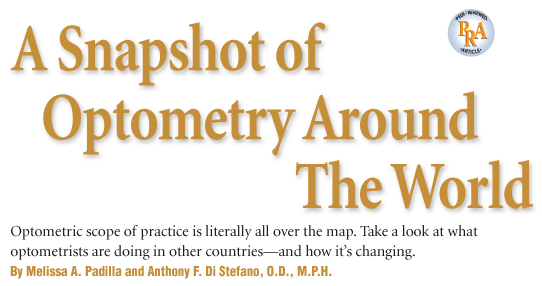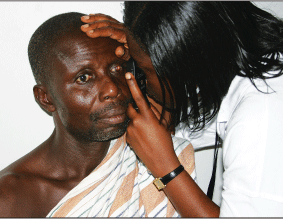
A worldwide panorama of optometry unveils an evolving montage of legislation, education, practice management, service delivery and public health initiatives that defines the profession, given the unique circumstances of every country. While some professional developments parallel those within the
This article provides a snapshot of the status of optometry in select countries. Comparisons are often equated with the World Council of Optometrys (WCO) Global Competency-Based Model of Scope of Practice in Optometry to reconcile the disparities in definitions and scope of practice around the world. (See A Global Model for Optometry, below.)
Asia and
Optometrist Akio Kanai of
In

In
Africa

A Ghanaian optometrist volunteers her services to a local patient.
Innovation is paramount to the delivery of eye and vision care in developing nations throughout
Three educational institutions accredited by the National Universities Commission offer optometry programs in
According to Nigerian Optometric Association President Uduak Udom, optometrists are permitted to perform comprehensive eye examinations, correction of refractive error, orthoptics, low vision, ocular first aid and treatment of minor eye diseases that do not pose a threat to the integrity of the visual system.3 This places Nigerian optometrists at the threshold of category 4: prescribing therapeutic agents. While the new National Health Insurance Scheme does not provide for optometric services in the three-year trial period, indications are that optometry will be included in the future. In the meantime, patients pay out-of-pocket.
South Africa
In
Pilot projects in Malawi and Mozambique now train mid-level and professional optometric personnel via a multiple entry/exit approach.5 Graduates from the two-year program may provide preventive eye care services, basic refraction, dispensing services and pathology screening in the public sector. Select graduates will complete two additional years of education to earn a Bachelors degree in optometry and work in either the public or private sector. Ultimately, success depends upon government recognition of the profession, multilateral collaboration and regulatory measures. Longevity and sustainability will require accessible eye care service centers that are strategically located in hospitals or clinics providing primary care.
A Global Model for Optometry In 2005, the World Council of Optometry (WCO) adopted the Global Competency-Based Model of Scope of Practice in Optometry, which provides a rational framework for addressing the challenges of professional harmonization.
Middle East
This historic document may stimulate greater uniformity when applied to teaching syllabi and statutory definitions of the scope of practice. It may also help regulatory bodies assure practitioner competency when faced with the migration of optometrists across national borders.
The model includes four categories of clinical care:
1. Optical technology services. Management and dispensing of ophthalmic lenses, ophthalmic frames and other ophthalmic devices that correct defects of the visual system.
2. Visual function services. Investigation, examination, measurement, diagnosis and correction/management of defects of the visual system.
3. Ocular diagnostic services. Investigation, examination and evaluation of the eye and adnexa, and associated systemic factors to detect, diagnose and manage disease.
4. Ocular therapeutic services. Use of pharmaceutical agents and other procedures to manage ocular conditions/disease.
The model reconciles variations in the scope of practiceto be defined as an optometrist, a practitioner must provide the services in both categories 1 and 2 at a minimum. This has become the entry-level threshold for the practice of optometry worldwide. In addition, it complements the unifying principle that optometrists strive to provide their patients with quality, cost-effective eye and vision care.
But, in 1995, the Israeli government approved the conversion of optometry to an academic profession and changed this restriction. Now, optometrists may serve as the primary point of access for all age rangesbut they must recommend that children under the age of six and adults 60 years and older also seek a medical eye exam from an ophthalmologist. This is based upon consensus among representatives from the Ministry of Health, ophthalmology and optometry. An official amendment will soon be presented before Parliament.
Two Israeli schools of optometry offer four-year academic degrees that permit graduates to provide visual function services (category 2). The Israel Council of Optometrists is currently seeking diagnostic privileges for qualified optometrists, advancing them to category 3 of the Global Model.
The United Kingdom (U.K.), on the other hand, recently passed a statute granting optometrists independent prescribing privilegesmoving them from diagnostic to therapeutic practice (category 4). Until now, optometrists could carry out some additional roles in supplying and administering medicines or prescribing them in partnership with a doctor Independent prescribing will mean that specially trained optometrists will be able to write a prescription if they diagnose a problem needing treatment, saving the patient from having to make a separate appointment with their GP.6
The Bachelors is the current entry-level degree for practicing optometry in the
The
Each aforementioned country is a member of the WCO, an international optometric organization with 75 member organizations that represent more than 40 countries. The WCO maintains official relations with the World Health Organization and membership in the International Agency for the Prevention of Blindness. These milestones help establish parity among optometry and other health care professions. Involvement with these global bodies provides optometry with a pubic platform to voice its concerns and contribute its expertise on an international level.
With the adoption of the Global Competency-Based Model of Scope of Practice in Optometry, international optometry is now poised to continue its dynamic growth within a framework that promotes professional career development that is responsive to the public health needs of society.
Ms. Padilla is the director of professional studies and international programs at
1. Optometrists Association Australia Web site. Milestones in Australian optometryEducation. Available at: www.optometrists.asn.au/optometry/milestones/education (accessed May 27, 2009).
2. Naidoo K. Poverty and blindness in
3. Udom U (personal communication, April 30, 2009).
4. Rosen H (personal communication, April 29, 2009).
5. Optometry Giving Sight. New School to Train 130 New Optical Staff. Press release. Available at: www.givingsight.org/about_us/news/boskco.asp (accessed May 8, 2009).
6. U.K. Department of Health. Prescriptions from Your High Street Opticians. Press release 2007 Aug 28. Available at: http://nds.coi.gov.uk/content/detail.asp?ReleaseID=310329&NewsAreaID=2 (accessed May 6, 2009).
7. London South Bank University Web site. Course Information. Available at: http://prospectus.lsbu.ac.uk/courses/course.php?UCASCode=unknown&CourseID=4501 (accessed May 27, 2009).
8. Levett J. Revalidation takes shape. General Optical Council Bulletin Winter 2009;12:6. Available at: www.optical.org/goc/filemanager/root/site_assets/publications/bulletins/Winter09.pdf (accessed May 6, 2009).

